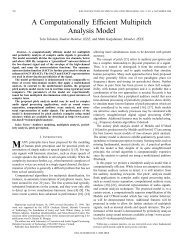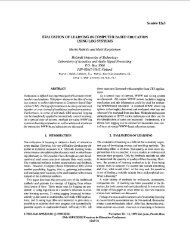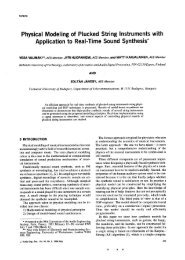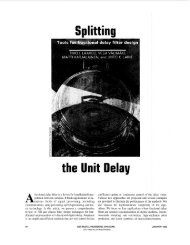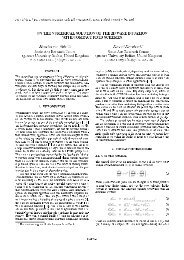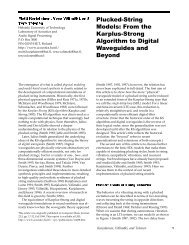Equalization of Audio Systems using Kautz Filters ... - TKK Acoustics
Equalization of Audio Systems using Kautz Filters ... - TKK Acoustics
Equalization of Audio Systems using Kautz Filters ... - TKK Acoustics
Create successful ePaper yourself
Turn your PDF publications into a flip-book with our unique Google optimized e-Paper software.
PAATERO AND KARJALAINEN<strong>Equalization</strong> <strong>using</strong> <strong>Kautz</strong> filters on log-scale1a) loudspeaker response1b) EQ: poles from inv. target700.50.560(g)0050(f)−0.50 50 10010.5c) delay in EQ target−0.50 50 10010.5d) delay and zeroslevel [dB]4030(e)(d)0020(c)−0.50 50 100−0.50 50 100Fig. 7: Early part <strong>of</strong> time-domain responses: a) measuredloudspeaker, b) LS equalized (<strong>Kautz</strong> filter order38), c) <strong>using</strong> the same set <strong>of</strong> poles and includingdelay (∆ = 12) in target, and d) by including 12poles at the origin and delay (∆ = 12) in target.<strong>Kautz</strong> filters the pole radii determine the maximumQ values <strong>of</strong> resonances. If the pole radii are selectedconservatively, no excess peaking and ringing <strong>of</strong> resonancesappear in the equalizer response.4.3. Loudspeaker equalization, Case 3In this subsection we demonstrate further the use <strong>of</strong><strong>Kautz</strong> modeling in loudspeaker equalization includingboth magnitude and phase correction. Whilein previous studies with warped and <strong>Kautz</strong> filters[7, 5, 21] we have applied magnitude-only equalization,it is interesting to investigate the ability <strong>of</strong><strong>Kautz</strong> inverse models to correct also the phase behavior.For clarity <strong>of</strong> phase curves, it is preferable to demonstratethe phase correction by <strong>using</strong> a synthetic (simulated)loudspeaker response instead <strong>of</strong> a real measuredone. Figures 9 and 10 depict the magnitudeand group delay behaviors <strong>of</strong> an idealized two-wayloudspeaker. It consists <strong>of</strong> a low-frequency driver ina wented box (4 th order highpass at 80 Hz) and ahigh-frequency driver (up to 18 kHz), both with flatresponse between roll-<strong>of</strong>f frequencies. They are combinedwith a second order Linkwitz-Riley crossover100(b)(a)10 2 10 3 10 4Frequency [Hz]Fig. 8: Basic example <strong>of</strong> loudspeaker response equalizationby <strong>Kautz</strong> filter inverse modeling. From bottomup: (a) measured magnitude response, (b) sameone 1/3-octave smoothed, (c) low and high roll-<strong>of</strong>fcompensation, (d) magnitude response <strong>of</strong> 24 th order(12 pole pairs) <strong>Kautz</strong> equalizer, (e) equalized magnituderesponse, (f) same one 1/3-octave smoothed,and (g) <strong>Kautz</strong> equalized response with R = 0.03.Vertical lines at 35 dB level indicate the frequencypositions corresponding to logarithmically spacedpole angles.network [10, 11], which in an ideal case results in aflat magnitude response at the main axis.In this particular case we investigate a loudspeakerwhere the acoustic center <strong>of</strong> the high-frequencydriver is 17 cm behind the acoustic center <strong>of</strong> thelow-frequency unit. This means a temporal nonalignment<strong>of</strong> about 0.5 ms, which results in ripple<strong>of</strong> the main axis magnitude response (‘Original’ inFig. 9) and similarly a non-flat group delay response(‘Original’ in Fig. 10). The magnitude response error<strong>of</strong> this amount is easily audible. Although thegroup delay deviation remains within 1 ms above 300Hz, which is hardly noticeable in practice, it is interestingto check how the phase correction by <strong>Kautz</strong>AES 120 th Convention, Paris, France, 2006 May 20–23Page 8 <strong>of</strong> 12






